Introduction
The art of API development goes beyond technical proficiency; it requires a deep understanding of the context in which the API will be used. Inconsistent naming conventions can lead to misunderstandings and fragmented APIs, complicating the integration process. To ensure clarity and smooth interaction between systems and stakeholders, a well-designed API must employ consistent and descriptive naming practices.
This article explores the importance of consistent naming conventions, the benefits of using descriptive subheadings, and the impact of using nouns to name URIs. It also provides guidance on avoiding deep nesting, special characters, and file extensions in URIs. By following these best practices, developers can create intuitive and user-friendly APIs that promote efficiency and productivity.
Why Consistent Naming Conventions are Crucial
The art of API development extends beyond mere technical proficiency; it encompasses a deep understanding of the context in which the API will be utilized. Consider the eye-opening experience of a project at Lufthansa, where the term "Flight" held seven distinct connotations, yet lacked clear definition or differentiation. The implications of such ambiguity are profound, particularly when we examine the multifaceted nature of an "Account" within .
Sales and marketing departments might interpret an account as a customer, complete with potential revenue and contact history, while finance sees it as a billing entity.
Misunderstandings arising from inconsistent naming conventions can lead to a fragmented and confusing API, complicating the integration process for developers and system architects. A well-designed API must, therefore, employ consistent and descriptive naming practices that resonate across various domains and departments. This is not just about adhering to a set of rules; it's about establishing a common language that ensures clarity and facilitates smooth interaction between disparate systems and stakeholders.
As we strive to build APIs that stand the test of time, we must acknowledge that standards evolve. What was once deemed a best practice might no longer be relevant in today's rapidly changing landscape. The challenge lies in navigating the labyrinth of existing systems, third-party inputs, and the diverse terminologies of different business units.
A consistent, descriptive, and domain-driven approach to naming can serve as a beacon, guiding us through the complexities of API development, ensuring that the systems we build today remain robust, maintainable, and scalable for the future.
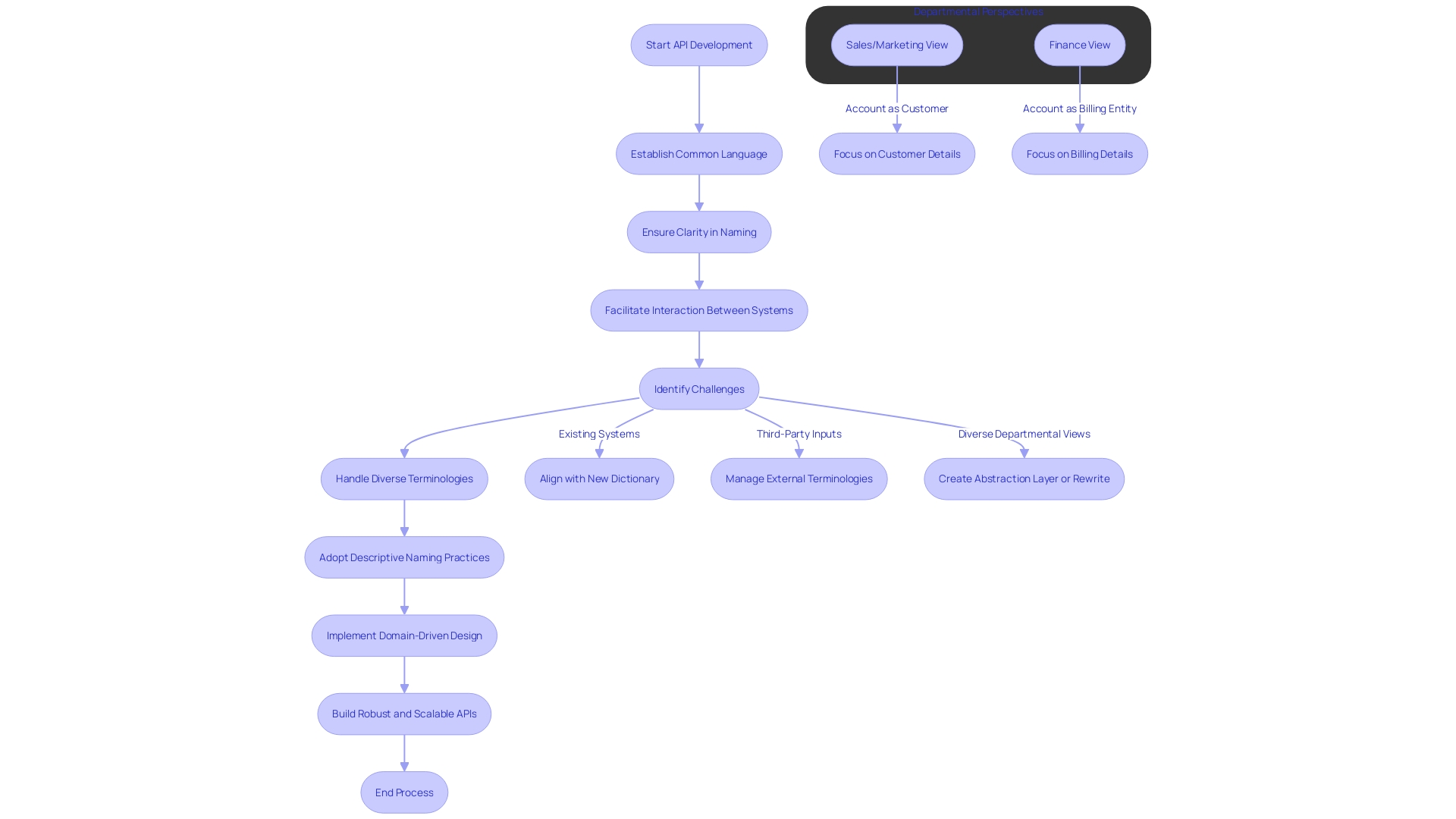
Main Sections
Crafting REST API documentation with precision and clarity is crucial for ensuring users can seamlessly integrate and interact with the API. To do this effectively, consider these guidelines:
- Organize Documentation Structurally: Break your API documentation into well-defined sections or chapters, each covering distinct aspects of your API. Use and lucid descriptions to lead users through the information systematically.
- Use Clear Naming Conventions: Ambiguity in naming can lead to confusion. For example, a project at Lufthansa revealed seven different interpretations for the term 'Flight'. Similarly, 'Account' can mean different things across departments: a potential customer in Sales or a billing entity in Finance. Clearly defining and differentiating such terms is essential.
- Employ Descriptive Subheadings: Subheadings should convey the content that follows. This helps in guiding users to the section relevant to their needs without unnecessary searching.
- Present Information Concisely: Utilize numbered lists or bullet points to articulate key concepts or procedures, enhancing the readability and accessibility of your documentation.
Remember, the goal is to create documentation that not only serves as a user manual but also as a comprehensive guide that is easy to understand and use. By incorporating these strategies, you'll produce API documentation that is both user-friendly and efficient.
Use Nouns to Name URIs
When , one should favor nouns that encapsulate the essence of the resources. For instance, rather than 'getBook', a more intuitive URI is '/books' for accessing book resources. This approach aligns with industry best practices, fostering an intuitive and stable API landscape.
An illustrative case is the experience shared by Nick Tune, who encountered multiple interpretations of 'Flight' within a single Lufthansa project. Such ambiguity highlights the necessity for clear and distinct naming conventions in API design.
Moreover, when constructing APIs for complex domains like 'Accounts', it's crucial to recognize the diverse interpretations across different departments. A Sales team might view an 'Account' as a customer profile, while Finance might treat it as a billing entity.
Andreas Thalhammer's work underscores the evolution of API design principles, reinforcing the importance of adapting to new standards rather than adhering to outdated 'best practices' without question.
The prevalence of APIs in today's digital ecosystem and the security risks associated with them, as reported in recent news, further underscore the importance of a thoughtful API design that not only ensures clarity but also secures sensitive data against breaches.
In light of these insights, the naming of API elements should not only reflect the resource but also consider the varied interpretations that may exist within an organization, ensuring a cohesive understanding across all departments.
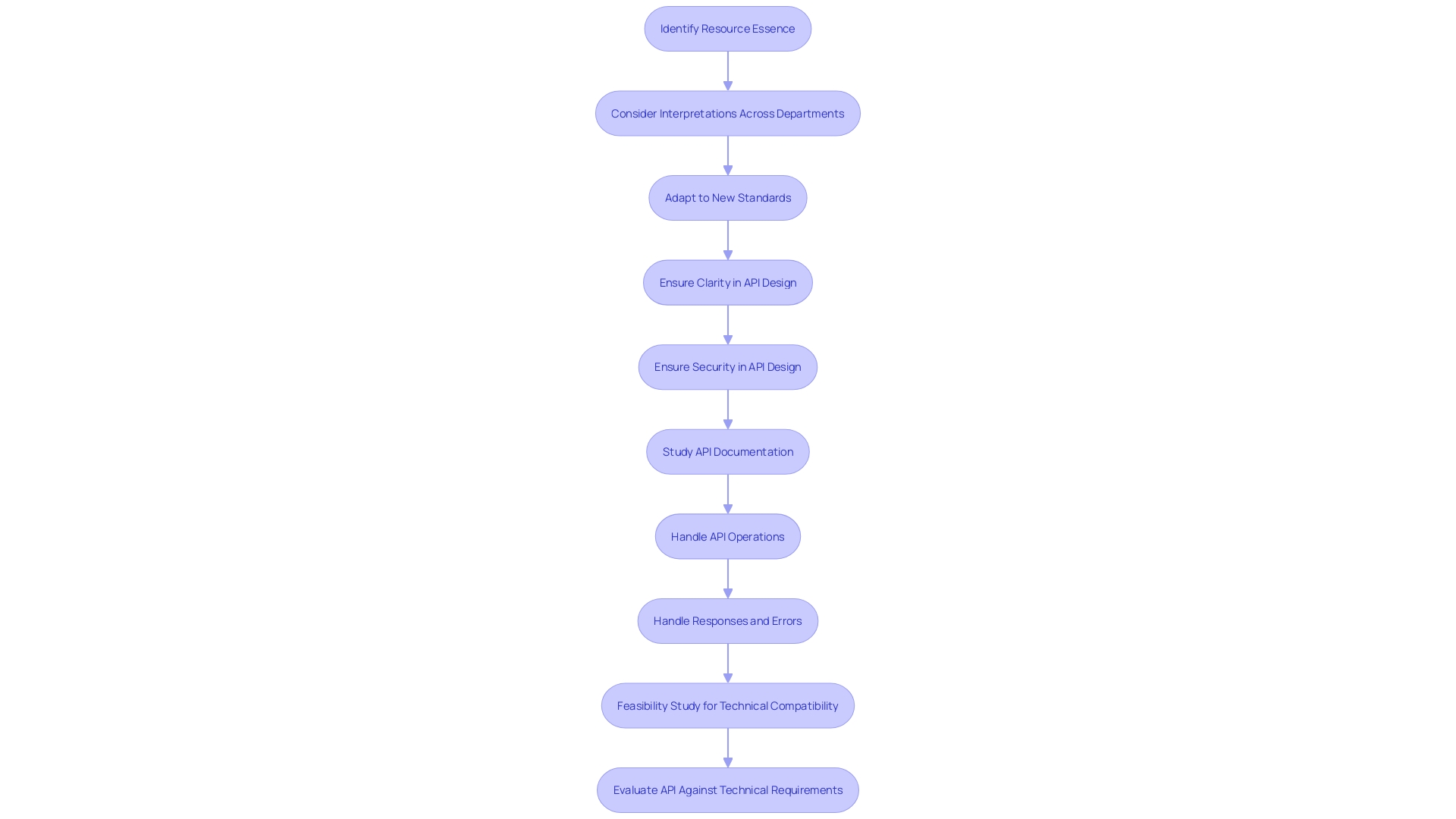
Avoid Deep Nesting and Special Characters
When , simplicity and clarity are paramount. Instead of creating deeply nested URIs that can confuse and complicate the user experience, aim for a shallow, straightforward structure. Complex URIs with multiple levels of nesting not only make it harder to understand the endpoint's functionality but also increase the risk of misconfiguration, which could lead to serious security vulnerabilities.
For instance, poorly defined access controls in nested URIs could result in Broken Function Level Authorization, allowing unauthorized users to access sensitive functions. This is especially concerning given that a recent scan of URLs by a security research team uncovered over 18,000 exposed API secrets, with 41% posing significant financial risks due to exposed tokens and keys.
Moreover, special characters in URIs should be avoided as they can lead to compatibility issues across different systems and reduce the readability of your API. Use only alphanumeric characters and hyphens to ensure your URIs remain clean and easily interpretable. Remember, the goal is to enable seamless communication between software components.
As highlighted by industry trends, the shift towards RESTful API design emphasizes the need for well-structured APIs that are intuitive to use, with verbs and objects clearly defining the actions to be performed.
Statistical evidence supports the critical role of APIs in modern organizations, with 93% of businesses recognizing their importance and 86% acknowledging that APIs prevent operational silos. Additionally, the integration of APIs with microservices is seen as a complementary strategy by 97% of industry respondents, pointing towards a unified approach for enhanced performance and productivity. Therefore, when constructing your endpoints, consider the broad impact and strive to make them as accessible and secure as possible for developers and end-users alike.
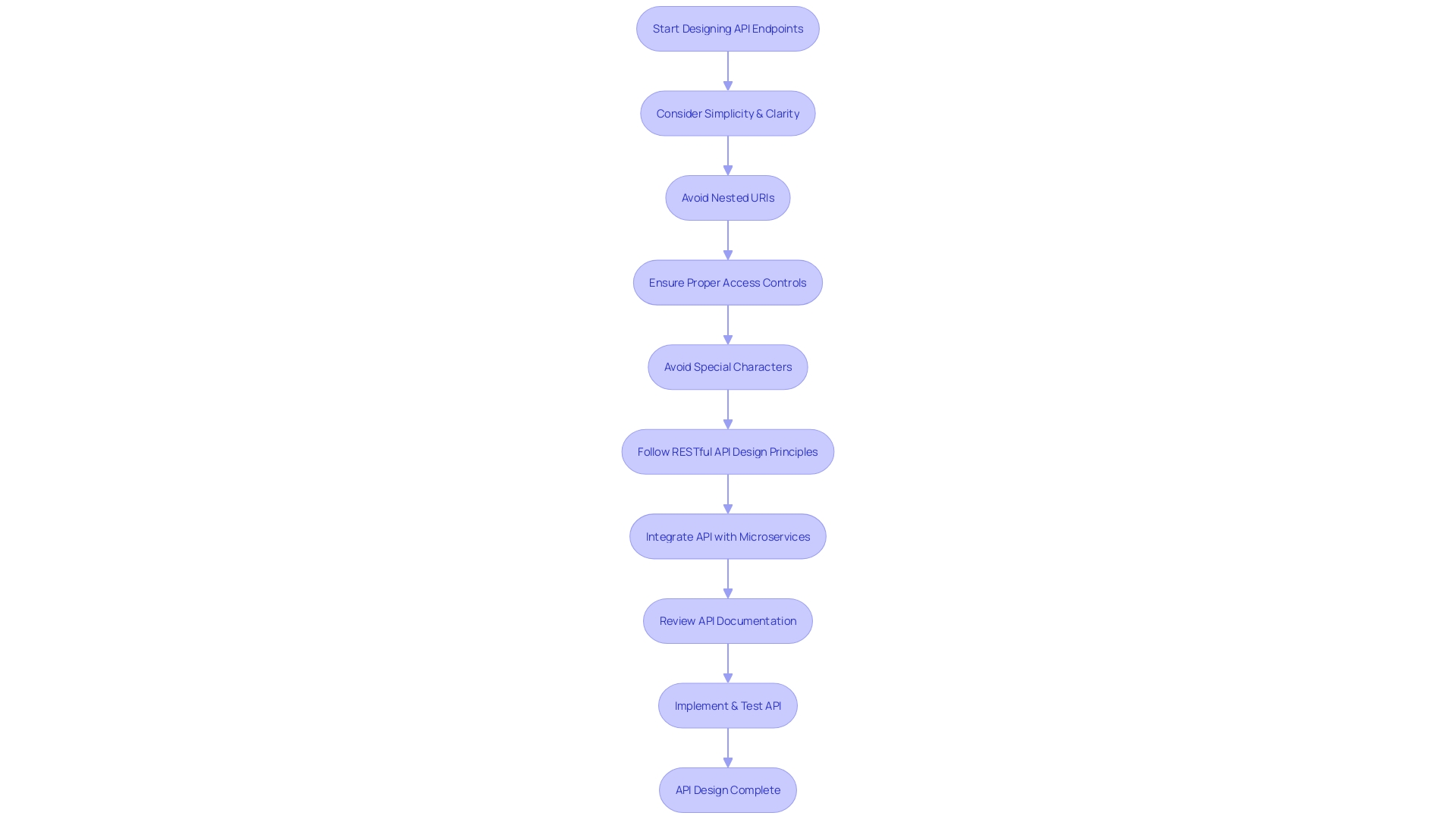
Use Plural Nouns for Resources
When designing REST APIs, an often underestimated yet critical decision is how resources are named. A well-considered naming convention can prevent confusion and make the API more intuitive. For instance, employing plural nouns for resource names indicates a collection rather than a single instance, thus '/users' is preferred over '/user'.
Consider Lufthansa's experience, where the term "Flight" had seven distinct interpretations within their Check-In software, creating ambiguity as it wasn't clearly defined. This illustrates the complexity of naming within domain modeling. Similarly, the 'Account' domain is notoriously intricate; varying interpretations exist across departments—Sales may view an 'Account' differently than Finance, influencing what they expect from an Account API.
Large enterprises often grapple with naming across numerous domains, and consistency becomes a challenge when aligning new APIs with legacy systems. For instance, Microsoft and SmartBear have demonstrated commitment to community engagement and ethical practices, which includes clear and responsible API design. The daily .NET link blog, The Morning Brew, also emphasizes the importance of effective communication in software development.
APIs form the backbone of our digitally connected landscape, facilitating seamless interactions between different software components. A weather app, for example, retrieves data from an external source via an API, emphasizing the essential nature of clear API endpoints for accurate data exchange. With this in mind, adopting plural nouns for resources in API design not only adheres to but also aligns with the evolving standards and the inherent need for clarity and simplicity in software communication.
Separate Words with Hyphens and Use Lowercase Letters
Clear and consistent naming in API URIs enhances usability and comprehension. A recommended approach is to use hyphens to separate words, which not only improves human readability but also ensures uniformity across diverse platforms and programming environments. Applying lowercase letters in URIs further contributes to this consistency, circumventing the complexity that arises from varying interpretations of URI case sensitivity.
Reflecting on real-world experiences, such as the one shared by Nick Tune regarding the ambiguity of the term 'Flight' in Lufthansa's API, underscores the importance of unambiguous naming. Similarly, the 'Account' domain often introduces complexity due to its varying meanings across different departments and contexts. These examples highlight the necessity for clearly defined and distinguishable identifiers in API design to avoid confusion and ensure that the API's intent is precisely conveyed.
APIs are more than mere technical constructs; they are contracts facilitating decoupling between systems. This perspective demands careful consideration when defining API paths and operations. For instance, debating the use of DELETE /reservations/{id} versus POST /reservations/{id}/cancel revolves around the implications for the underlying reservation resource's state.
Such decisions have long-term consequences, as the software is likely to outlive its original specifications.
Organizing documentation in a logical, layered approach is crucial, starting with fundamental concepts and progressing to more complex topics. This strategy, complemented by , empowers users with varied expertise levels to engage effectively with the API. Search functionality within the documentation further aids in locating specific information efficiently.
In the evolving landscape of API design, where outdated practices are challenged, the drive towards excellence is evident. APIs serve as the linchpin in data engineering, enabling seamless communication between disparate software systems. They are the cornerstone of modern software development, where the goal is not merely to facilitate data flow but to do so with precision, efficiency, and scalability.
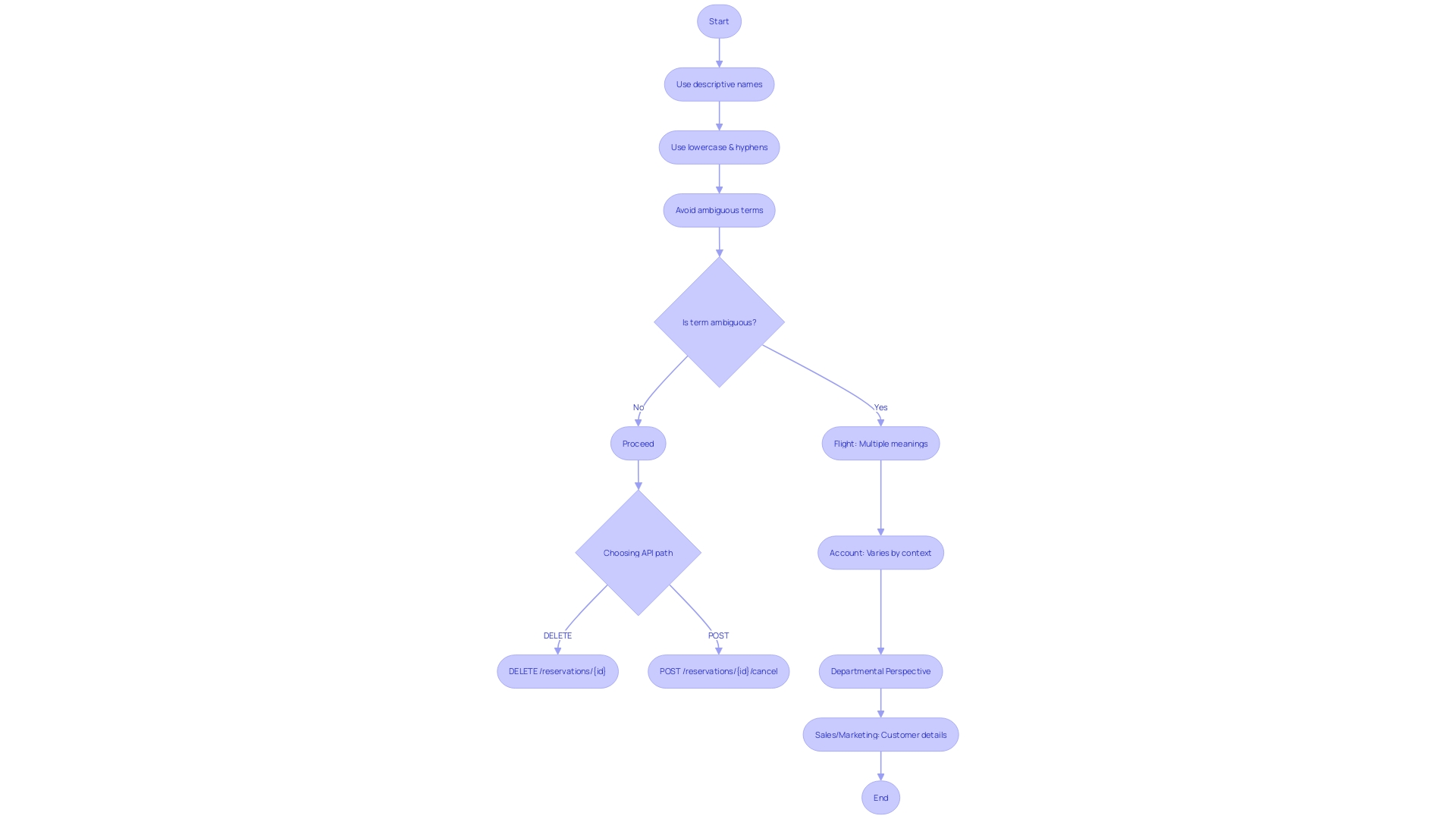
Avoid Using File Extensions in URIs
Crafting intuitive and user-friendly REST API URIs is essential for developers to interact with web resources effectively. Historically, appending file extensions like '.json' or '.xml' to URIs was a common practice. However, this approach is now considered antiquated and can lead to confusion and complexity.
Instead, content negotiation is recognized as a more streamlined method for determining the appropriate response format, promoting simplicity and clarity in API design.
The evolution of API design principles over time underscores the need to reassess and adapt conventions. For instance, the once widespread use of prefixing unstandardized parameters with 'X-' has been deprecated due to the problems it creates, as noted in RFC 6648. This shift reflects the ongoing change and development within software standards, where persistence in outdated practices is not necessarily indicative of best practices.
Embracing content negotiation over URI file extensions aligns with the ethos that 'Cool URIs don't change,' a principle that has remained relevant despite advancements in the field. In keeping with this philosophy, RESTful API design encourages the use of HTTP headers to communicate data format preferences, thereby avoiding the rigidity of URI-based file extensions.
This approach is supported by the broader industry's move towards more , as highlighted in recent discussions around the need for distributed and federated API ecosystems. Organizations such as Microsoft and SmartBear have emphasized the importance of community engagement and ethical practices in technology, which resonates with the push for more adaptable and user-centric API designs.
Moreover, the importance of well-structured URIs is evident in real-world applications, such as Lufthansa's 'Check-In' software, where clear identifiers were crucial for differentiating among the various interpretations of 'Flight.' Similarly, the domain of 'Accounts' demonstrates the complexity of API modeling, where a single term can have vastly different meanings across departments and contexts.
Statistics further reveal the significance of RESTful APIs in the modern web, with a comprehensive guide emphasizing their role in creating, retrieving, updating, and deleting data across platforms. Research by Vanson Bourne in 2021 showed that APIs are considered essential by 93% of organizations, with 86% agreeing that APIs prevent operational silos. The synergistic relationship between APIs and microservices, acknowledged by 97% of respondents, illustrates the impact of well-designed APIs on customer satisfaction, productivity, and time savings.
In summary, developers are encouraged to leverage content negotiation for response format specification in RESTful APIs, aligning with current best practices and contributing to the creation of more efficient, user-friendly API endpoints.
Examples of Well-Named REST API Endpoints
To exemplify the best practices for API endpoint naming, let's consider the universally used RESTful API standard. The clarity of an endpoint is critical, as it represents a specific function or resource within the API. For instance:
- GET /users: Fetches a list of users
- POST /users: Creates a new user
- GET /users/{id}: Retrieves a user by their unique identifier
- PUT /users/{id}: Updates a user's information based on their unique identifier
- DELETE /users/{id}: Removes a user based on their unique identifier
By adhering to these standardized conventions, developers can quickly comprehend and utilize your API's functionalities. This consistency in naming is not just about adhering to convention; it's about creating an intuitive understanding for all developers who might interact with your API.
In the world of software, where 'Accounts' can mean vastly different things depending on the context—ranging from potential customers in sales to billing entities in finance—it is crucial to adopt a nomenclature that is both explicit and contextually relevant.
The significance of standardized API endpoints cannot be overstated. As Microsoft's SmartBear highlights, meeting customers where they are is essential for driving our technology-forward society. With RESTful APIs being the most prevalent, their endpoints must be well-structured and named with precision to facilitate between software components.
Nick Tune's involvement in Lufthansa's 'Check-In' software project underscores the importance of clear definitions. With seven different interpretations of 'Flight', the absence of explicit naming led to confusion. This anecdote serves as a cautionary tale for API developers to prioritize unequivocal naming to avoid ambiguity and streamline software interactions.
Remember, the evolution of standards is ongoing, and what may have been considered a 'best practice' can become obsolete. It is imperative to continually assess and refine API practices to ensure they align with current needs and technological advancements.
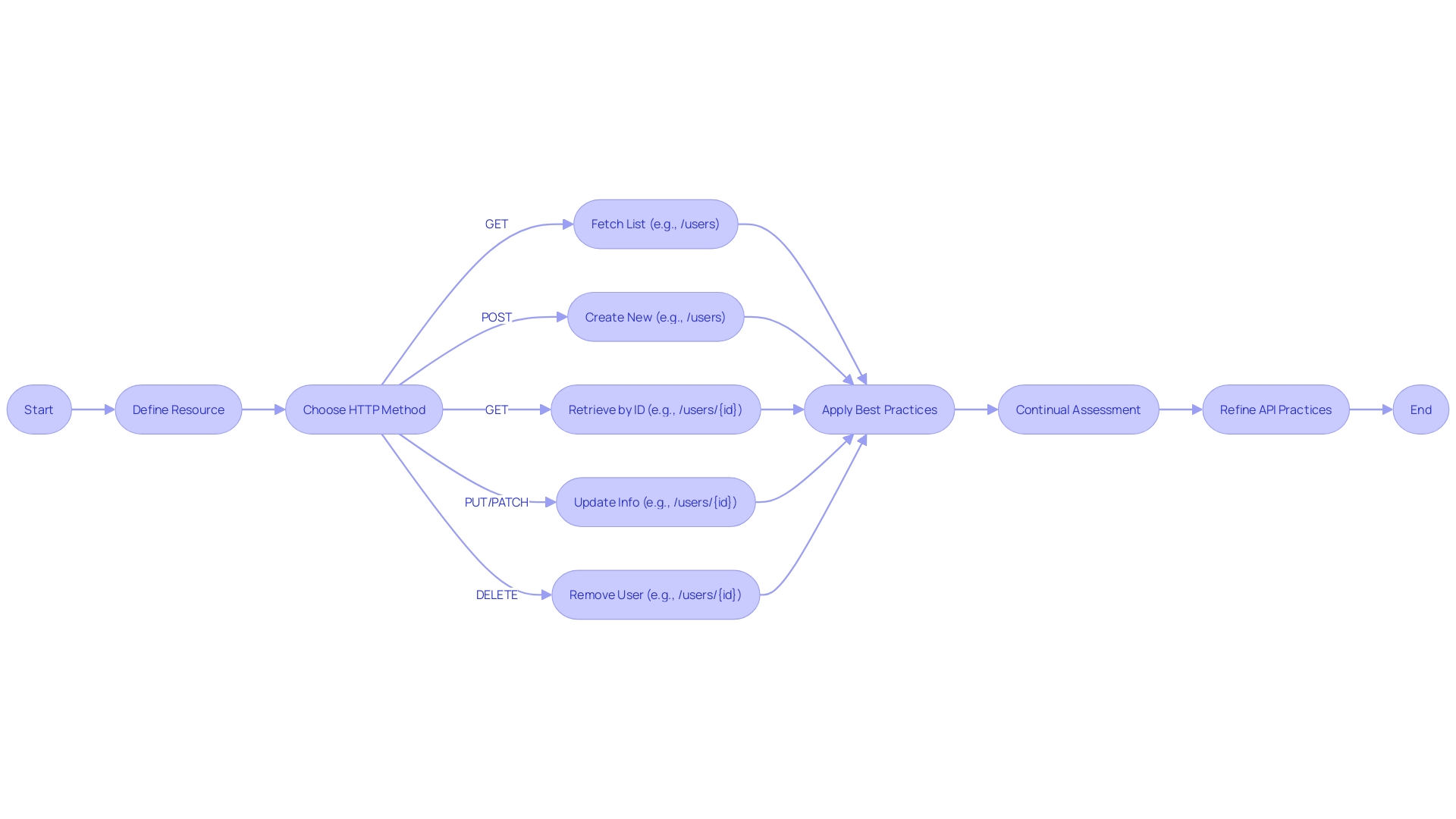
Common Mistakes to Avoid in REST API Naming
Crafting API endpoints with precision and care is crucial for creating a reliable and intuitive interface. Common pitfalls can quickly derail the user experience, such as the misuse of verbs where nouns should reign supreme in URIs. A well-structured API should avoid deeply nesting URIs, which can complicate the overall structure and lead to confusion.
Special characters are to be shunned in URIs, maintaining simplicity and predictability. Consistency is key, especially with capitalization, ensuring a seamless interaction for users.
Consider the cautionary tales from industry experiences, such as the project at Lufthansa where the term "Flight" adopted seven different interpretations without clear definition or distinct naming, creating a labyrinth of confusion. The complexity of the 'Account' domain serves as another testament to the intricacies of API design. Depending on the perspective – be it Sales, Marketing, or Finance – the meaning of 'Account' can shift dramatically, each requiring unique information and interaction.
The importance of a unified naming convention cannot be overstated; a data dictionary or catalog can serve as a cornerstone for clarity. This becomes even more critical in with numerous domains and existing systems. The introduction of new standards often requires navigating the inertia of outdated practices, as highlighted by the historical use of the "X-" prefix for non-standard parameters.
As we evolve past these conventions, it's essential to question the status quo and redefine what constitutes a best practice.

References/Citations
The C4 model, created by Simon Brown, is an architectural framework designed to offer a comprehensive view of software systems at varying levels of detail. Each level—Context, Containers, Components, and Code—aims to present a specific aspect of the software architecture, ensuring that stakeholders like business analysts, product owners, and team leads can grasp the system in relation to its broader environment. This approach is crucial for understanding the system's role within the business ecosystem and its interactions with external entities, be it users or other systems.
Recent trends in architecture emphasize socio-technical considerations, acknowledging the importance of the people involved in building, supporting, and maintaining systems. This shift is reflected in new methodologies like Team Topologies and insights from Conway's Law, which suggest that the system's design should take into account the structure and communication paths of the team creating it. These perspectives were highlighted at the QCon London 2023 conference, where the significance of socio-technical architecture was a key topic of discussion.
In scientific writing, clarity and simplicity are paramount. Excessive jargon can impede understanding, so it's essential to introduce terms clearly when they first appear. Research indicates that articles written with less complexity and a personal voice, particularly in the introduction, garner more citations.
This suggests that the most is not only well-organized and data-driven but also accessible and relatable.
Conclusion
In conclusion, consistent naming conventions in API development are essential for clarity and smooth interactions between systems and stakeholders. Well-designed APIs employ descriptive naming practices that promote efficiency and productivity.
Clear subheadings in API documentation help organize information and guide users effectively. Avoiding ambiguity in naming is crucial for seamless communication across different domains and departments.
When naming URIs, using nouns that encapsulate the essence of resources is recommended. Avoiding deep nesting and special characters in URIs ensures simplicity, compatibility, and reduces the risk of misconfiguration and security vulnerabilities.
Content negotiation should be embraced instead of using file extensions in URIs. This approach promotes simplicity and clarity in API design, aligning with evolving standards.
Adopting plural nouns for resource names in REST APIs enhances usability and prevents confusion. Well-structured and named API endpoints facilitate efficient and secure interactions between software components.
To achieve maximum efficiency, developers should avoid common mistakes such as misusing verbs in URIs, deep nesting, special characters, and inconsistent capitalization. Consistency in naming conventions and clear definitions are crucial for avoiding confusion and streamlining software interactions.
In summary, following best practices for consistent naming conventions, descriptive subheadings, and avoiding common mistakes enables developers to create intuitive and user-friendly APIs that promote efficiency and productivity. These practices align with evolving standards, ensuring clarity and smooth interaction between systems and stakeholders.
Frequently Asked Questions
What is the significance of consistent naming conventions in API development?
Consistent naming conventions in API development ensure clarity and facilitate smooth interaction between different systems and stakeholders, preventing misunderstandings and confusion that can arise from ambiguous terminology.
How did Lufthansa's experience highlight the importance of clear naming in API development?
Lufthansa's experience demonstrated the potential for confusion when a single term, such as 'Flight,' had multiple interpretations without clear definition, emphasizing the need for distinct and unambiguous naming conventions.
Why is it essential to use nouns to name URIs in a REST API?
Using nouns to name URIs reflects the resource-oriented architecture of REST APIs, making them more intuitive and aligning with industry best practices by indicating the essence of the resources being accessed.
What are the drawbacks of deep nesting and the use of special characters in URIs?
Deep nesting can confuse users and complicate the user experience, while special characters can lead to compatibility issues and reduced readability. Both practices should be avoided to ensure clear and secure API endpoints.
Should plural or singular nouns be used for naming resources in REST APIs?
Plural nouns are preferred for naming resources as they suggest a collection of items, which is more intuitive for users interacting with an API.
What is the recommended way to separate words in API URIs?
Hyphens are recommended for separating words in API URIs to improve readability and ensure uniformity across platforms. Lowercase letters should also be used to avoid issues with case sensitivity.
Why should file extensions be avoided in URIs?
File extensions in URIs are now considered outdated and can introduce confusion. Content negotiation via HTTP headers is a more flexible and contemporary approach to handling response formats.
Can you provide examples of well-named REST API endpoints?
Yes, examples include:
- GET /users: Fetches a list of users.
- POST /users: Creates a new user.
- GET /users/{id}: Retrieves a user by their identifier.
- PUT /users/{id}: Updates a user's information.
- DELETE /users/{id}: Removes a user.
What are some common mistakes to avoid in REST API naming?
Common mistakes include using verbs instead of nouns in URIs, deeply nesting URIs, using special characters, and inconsistent capitalization.
How does the C4 model relate to API design and naming conventions?
The C4 model provides a framework for detailing software architecture at different levels, which is critical for understanding the role of the system and its interactions with other entities. Clear naming conventions in API design complement this model by enhancing overall system clarity.
What recent trends were discussed at the QCon London 2023 conference regarding API design?
The QCon London 2023 conference highlighted the significance of socio-technical architecture, which takes into account the structure and communication patterns of the team creating the system, emphasizing the relationship between system design and the people involved.
Why is simplicity important in scientific writing and API documentation?
Simplicity in writing and documentation enables better understanding and accessibility for a broader audience. It ensures that complex concepts are communicated effectively, which is particularly important for API documentation where users with varying expertise levels need to engage with the API.




